Tribological Properties of Mo2N Films at Elevated Temperature
Abstract
:1. Introduction
2. Experiment
3. Results and Discussion
3.1. Microstructure and Mechanical Properties
3.2. Tribological Properties
4. Conclusions
Author Contributions
Funding
Acknowledgments
Conflicts of Interest
References
- Polcar, T.; Parreira, N.; Cavaleiro, A. Tribological characterization of tungsten nitride coatings deposited by reactive magnetron sputtering. Wear 2008, 262, 655–665. [Google Scholar] [CrossRef]
- Bondarev, A.V.; Kvashnin, D.G.; Shchetinin, I.V.; Shtansky, D.V. Temperature-dependent structural transfor- mation and friction behavior of nanocomposite VCN-(Ag) coatings. Mater. Des. 2018, 160, 964–973. [Google Scholar] [CrossRef]
- Klima, S.; Jäger, N.; Hruby, H.; Mitterer, C.; Keckes, J.F.; Burghammer, M.; Daniel, R. Structure-stress relation- ships in nanocrystalline multilayered Al0.7Cr0.3N/Al0.9Cr0.1N coatings studied by cross-sectional X-ray nanodi- ffraction. Mater. Des. 2019, 170, 107702. [Google Scholar] [CrossRef]
- Gassner, G.; Mayrhofer, P.H.; Kutschej, K.; Mitterer, C.; Kathrein, M. Magnéli phase formation of PVD Mo-N and W-N coatings. Surf. Coat. Technol. 2006, 201, 3335–3341. [Google Scholar] [CrossRef]
- Kindlund, H.; Sangiovanni, D.G.; Petrov, I.; Greene, J.E.; Hultman, L. A review of the intrinsic ductility and toughness of hard transition-metal nitride alloy thin films. Thin Solid Films 2019, 688, 137479. [Google Scholar] [CrossRef]
- Ju, H.; Ding, N.; Xu, J.; Yu, L.; Asempah, I.; Xu, J.; Yi, G.; Ma, B. Crystal structure and the improvement of the mechanical and tribological properties of tungsten nitride films by addition of titanium. Surf. Coat. Technol. 2018, 345, 132–139. [Google Scholar] [CrossRef]
- Musil, J.; Kos, Š.; Zenkin, S. β-(Me1,Me2) and MeNx films deposited by magnetron sputtering: Novel heterostructural alloy and compound films. Surf. Coat. Technol. 2017, 337, 75–81. [Google Scholar] [CrossRef]
- Aouadi, S.M.; Paudel, Y.; Luster, B.; Stadler, S.; Kohli, P.; Muratore, C.; Hager, C.; Voevodin, A.A. Adaptive Mo2N/MoS2/Ag tribological nanocomposite coatings for aerospace applications. Tribol. Lett. 2008, 29, 95–103. [Google Scholar] [CrossRef]
- Aouadi, S.M.; Paudel, Y.; Simonson, W.J.; Ge, Q.; Kohli, P.; Muratore, C.; Voevodin, A.A. Tribological investigation of adaptive Mo2N/MoS2/Ag coatings with high sulfur content. Surf. Coat. Technol. 2009, 203, 1304–1309. [Google Scholar] [CrossRef]
- Zhang, G.; Fan, T.; Wang, T.; Chen, H. Microstructure, mechanical and tribological behavior of MoNx/SiNx multilayer coatings prepared by magnetron sputtering. Appl. Surf. Sci. 2013, 274, 231–236. [Google Scholar] [CrossRef]
- Ozturk, A.; Ezirmil, K.V.; Kazmanli, K.; Urgen, M.; Eryilmaz, O.L.; Erdemir, A. Comparative tribological behaviors of TiN-, CrN- and MoN-Cu nanocomposite coatings. Tribol. Int. 2008, 41, 49–59. [Google Scholar] [CrossRef]
- Solak, N.; Ustel, F.; Urgen, M.; Aydin, S.; Cakir, A.F. Oxidation behavior of molybdenum nitride coatings. Surf. Coat. Technol. 2003, 174–175, 713–719. [Google Scholar] [CrossRef]
- Sarioglu, C.; Demirler, U.; Kazmanli, M.; Urgen, M. Measurement of residual stresses by X-ray diffraction techniques in MoN and Mo2N coatings deposited by arc PVD on high-speed steel substrate. Surf. Coat. Technol. 2005, 190, 238–243. [Google Scholar] [CrossRef]
- Suszko, T.; Gulbinski, W.; Jagielski, J. Mo2N/Cu thin films-the structure, mechanical and tribological properties. Surf. Coat. Technol. 2006, 200, 6288–6292. [Google Scholar] [CrossRef]
- Ju, H.; Yu, D.; Xu, J.; Yu, L.; Zuo, B.; Geng, Y.; Huang, T.; Shao, L.; Ren, L.; Du, C.; et al. Crystal structure and tribological properties of Zr-Al-Mo-N composite films deposited by magnetron sputtering. Mater. Chem. Phys. 2019, 230, 347–354. [Google Scholar] [CrossRef]
- Luo, Q. Temperature dependent friction and wear of magnetron sputtered coating TiAlN/VN. Wear 2011, 271, 2058–2066. [Google Scholar] [CrossRef] [Green Version]
- Ju, H.; Ding, N.; Xu, J.; Yu, L.; Geng, Y.; Ahmed, F. The bribological behavior of niobium nitride and silver composite films at elevated testing temperatures. Mater. Chem. Phys. 2019, 237, 121840. [Google Scholar] [CrossRef]
- Ju, H.; Yu, D.; Yu, L.; Ding, N.; Xu, J.; Zhang, X.; Zheng, Y.; Yang, L.; He, X. The influence of Ag contents on the microstructure, mechanical and tribological properties of ZrN-Ag films. Vacuum 2018, 148, 54–61. [Google Scholar] [CrossRef]
- Ju, H.; Ding, N.; Xu, J.; Yu, L.; Geng, Y.; Yi, G.; Wei, T. Improvement of tribological properties of niobium nitride films via copper Addition. Vacuum 2018, 158, 1–5. [Google Scholar] [CrossRef]
- Ju, H.; Yu, L.; Yu, D.; Asempah, I.; Xu, J. Microstructure, mechanical and trobological properties of TiN-Ag films deposited by reactive magnetron sputtering. Vacuum 2017, 141, 82–88. [Google Scholar] [CrossRef]
- Xu, J.; Ju, H.; Yu, L. Microstructure, oxidation resistance, mechanical and tribological properties of Mo-Al-N films by reactive magnetron sputtering. Vacuum 2014, 103, 21–27. [Google Scholar] [CrossRef]
- Kutschej, K.; Mayrhofer, P.H.; Kathrein, G.M.; Polcik, P.; Mitterer, C. A new low-friction concept for Ti1−xAlxN based coatings in high-temperature applications. Surf. Coat. Technol. 2004, 188, 358–363. [Google Scholar] [CrossRef]
- Franz, R.; Lechthaler, M.; Polzer, C.; Mitterer, C. Oxidation behaviour and tribological properties of arc-evaporated ZrAlN hard coatings. Surf. Coat. Technol. 2012, 206, 2337–2345. [Google Scholar] [CrossRef]
- Yang, J.F.; Yuan, Z.G.; Liu, Q.; Wang, X.P.; Fang, Q.F. Characterization of Mo-Al-N nanocrystalline films synthesized by reactive magnetron sputtering. Mater. Res. Bull. 2009, 44, 86–90. [Google Scholar] [CrossRef]
- Al-Jaroudi, S.S.; Ul-Hamid, A.; Mohammed, A.I.; Saner, S. Use of X-ray powder diffraction for quantitative analysis of carbonate rock reservoir samples. Powder Technol. 2007, 175, 115–121. [Google Scholar] [CrossRef]
- Wang, D.; Su, D.S.; Schlogl, R. Electron beam induced transformation of MoO3 to MoO2 and a new phase MoO. Inorg. Chem. 2004, 630, 1007–1014. [Google Scholar]
- Ju, H.; Ding, N.; Xu, J.; Yu, L.; Geng, Y.; Ahmed, F.; Zuo, B.; Shao, L. The influence of crystal structure and the enhancement of mechanical and frictional properties of titanium nitride film by addition of ruthenium. Appl. Surf. Sci. 2019, 489, 247–254. [Google Scholar] [CrossRef]
- Ju, H.; Yu, L.; He, S.; Asempah, I.; Xu, J.; Hou, Y. The enhancement of fracture toughness and tribological properties of the titanium nitride films by doping yttrium. Surf. Coat. Technol. 2017, 321, 57–63. [Google Scholar] [CrossRef]
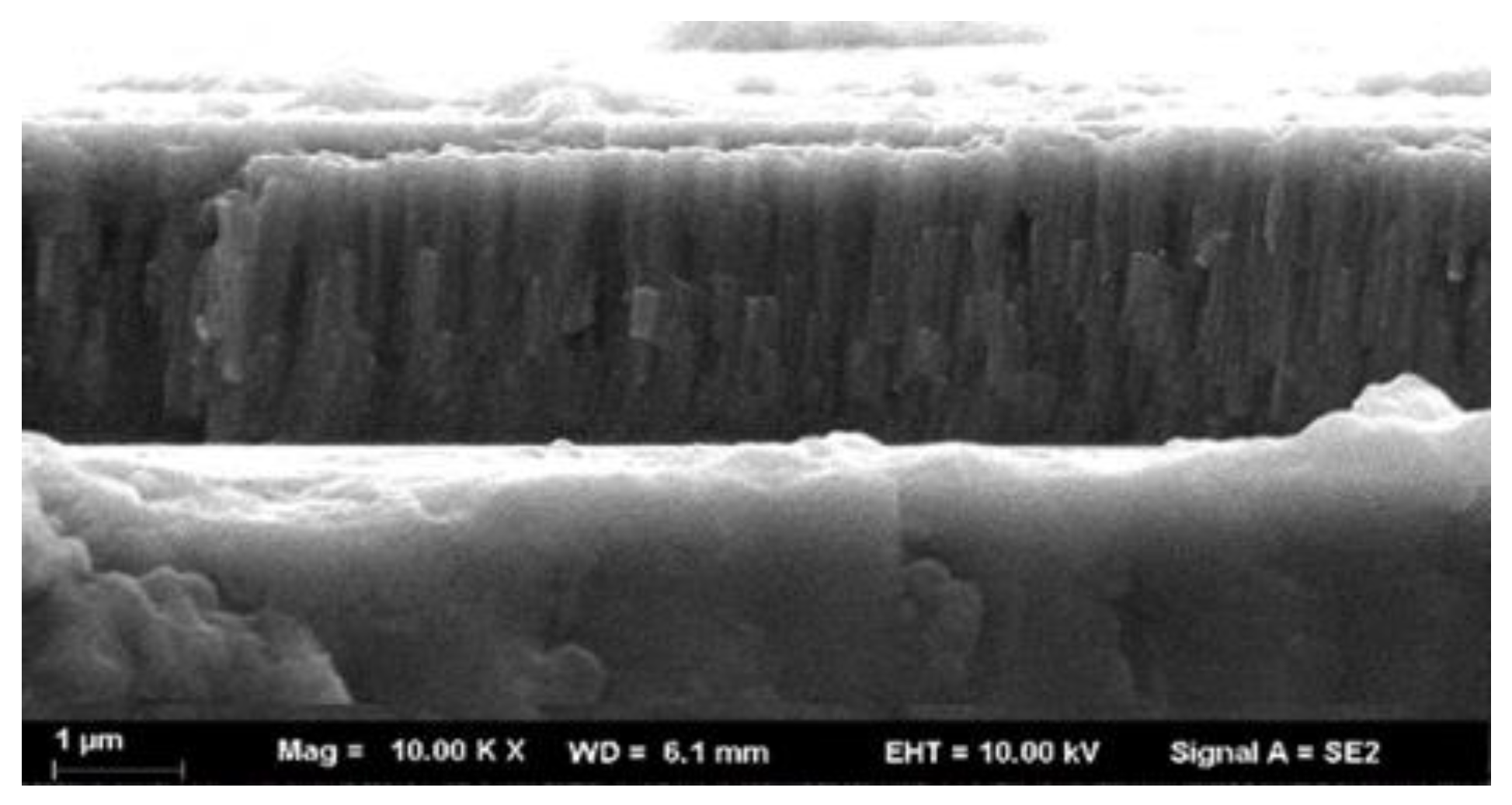
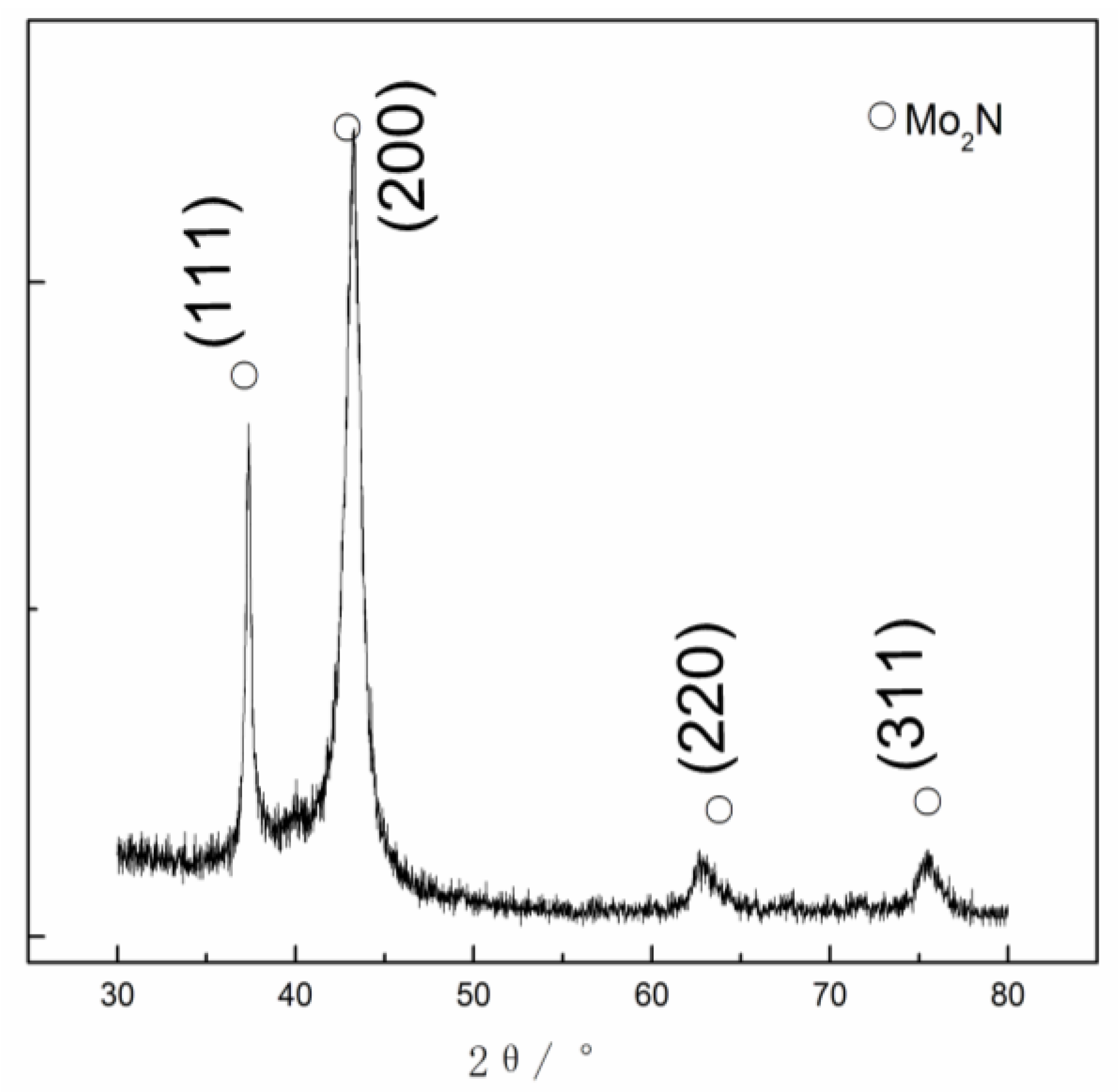
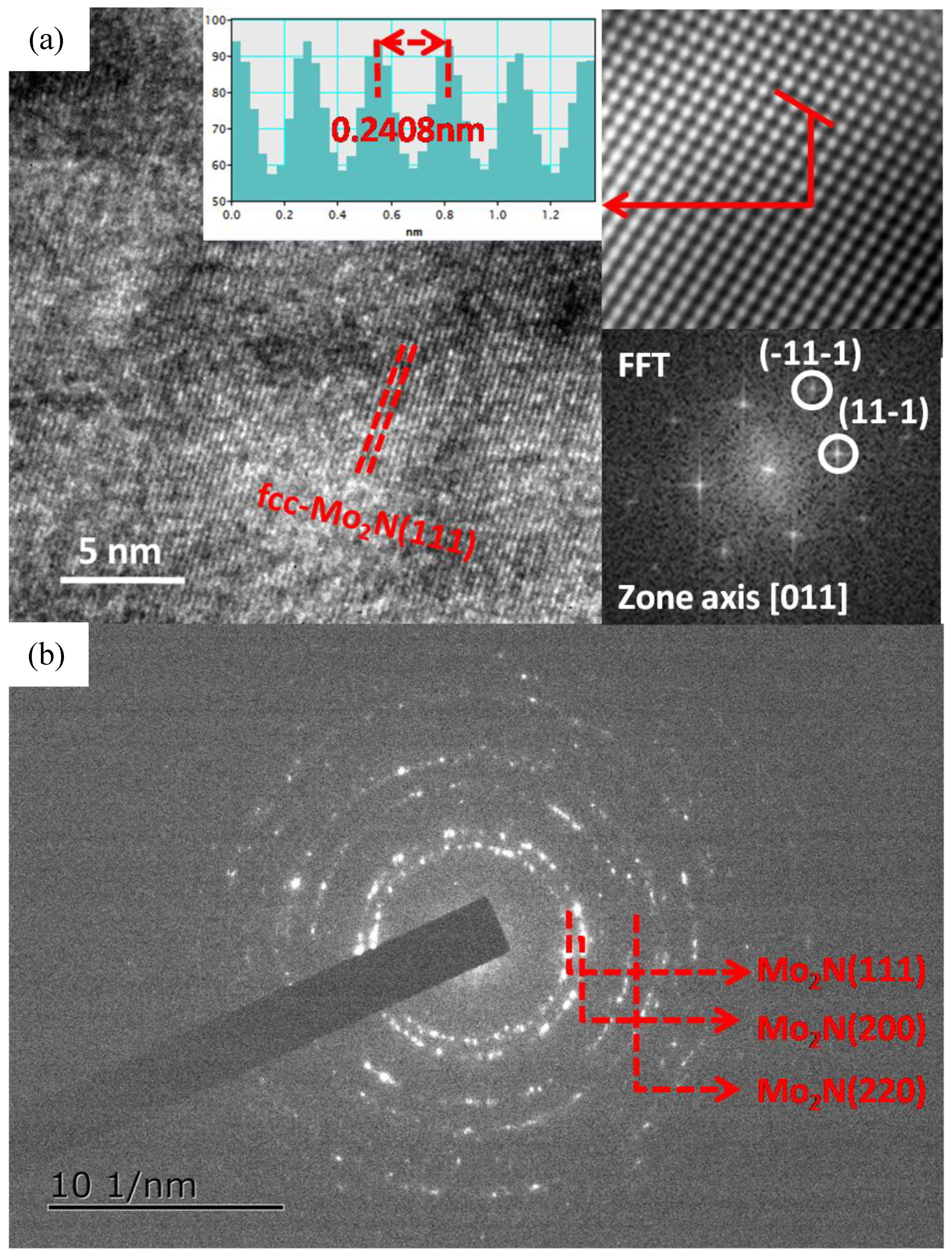
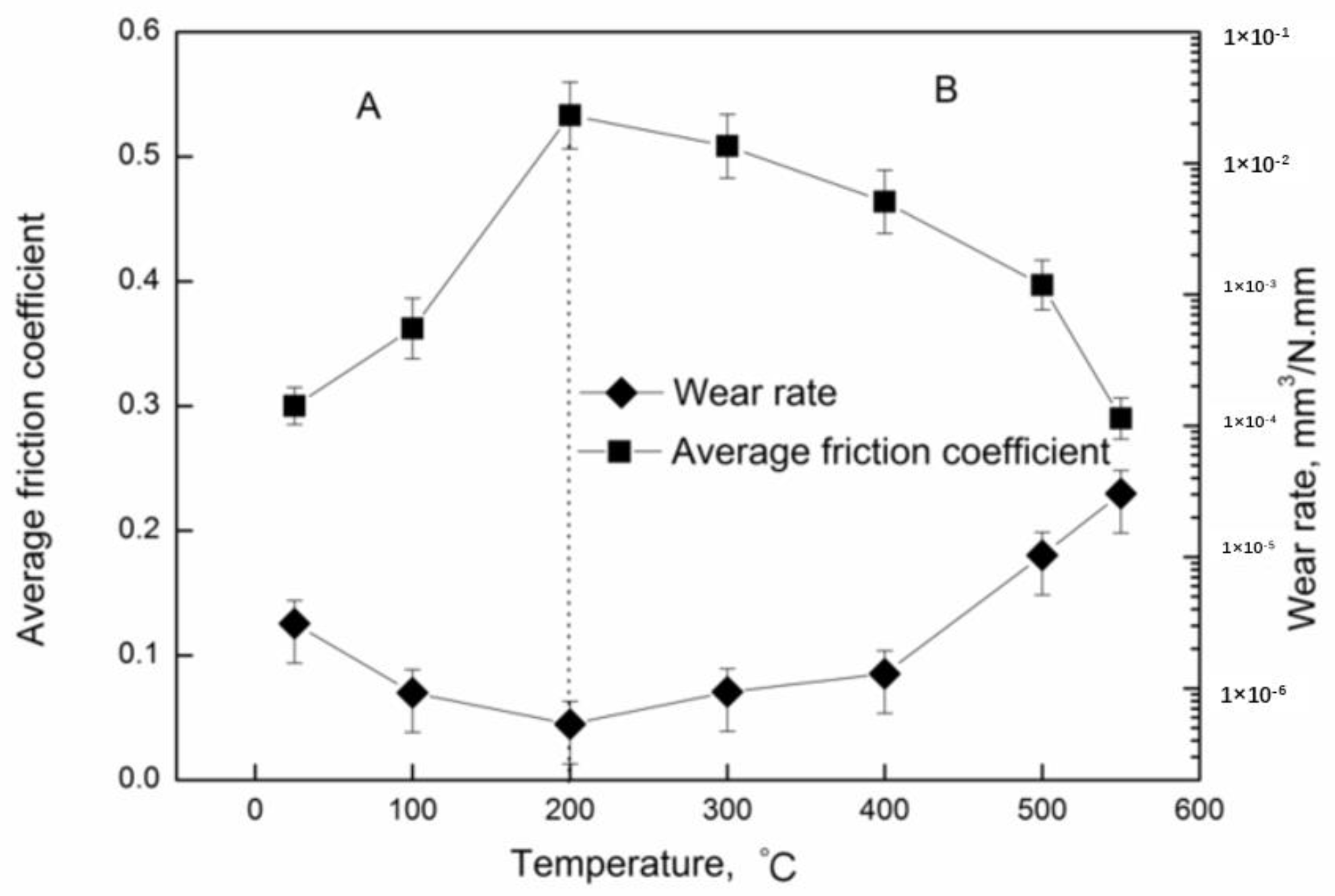
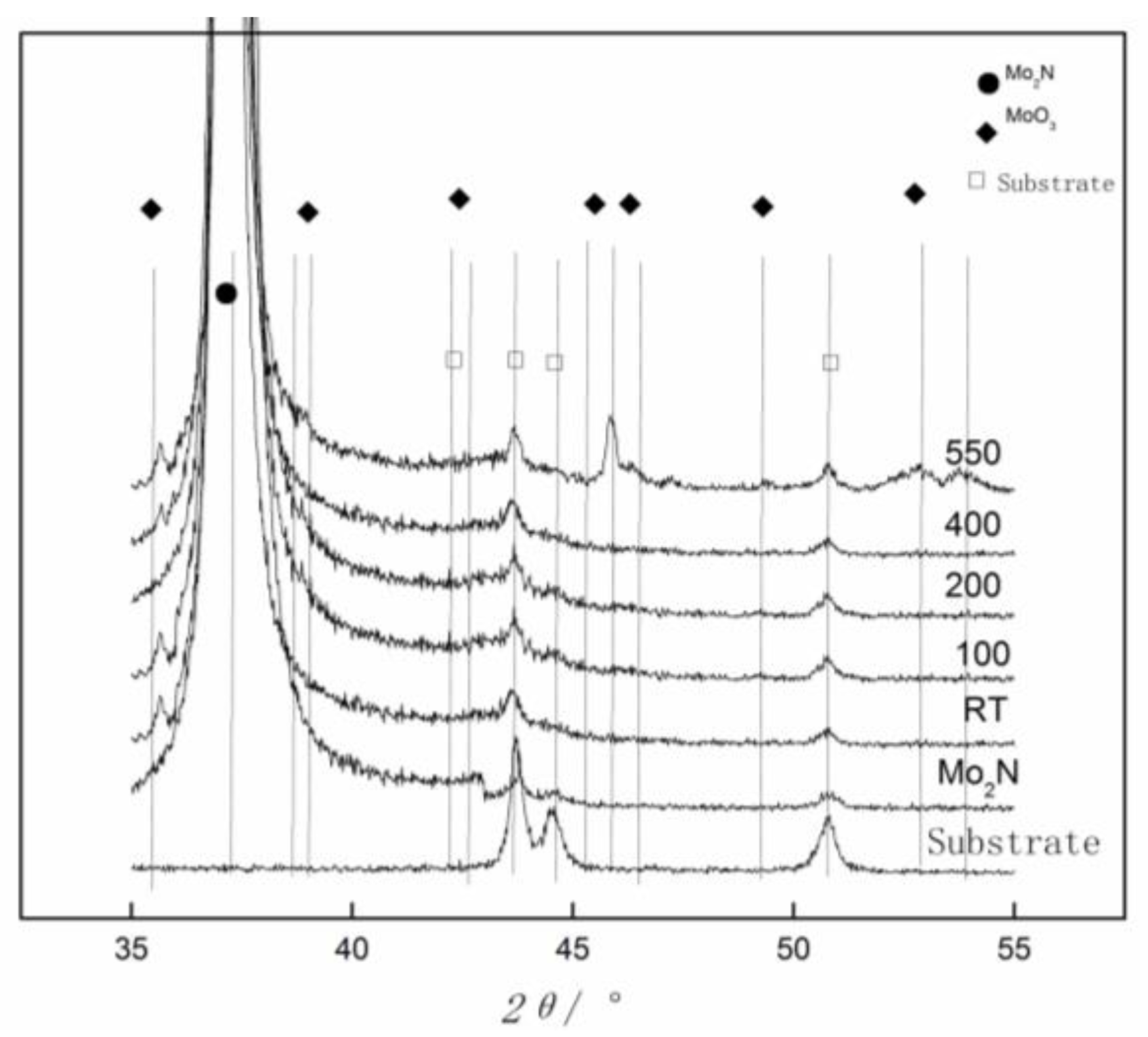
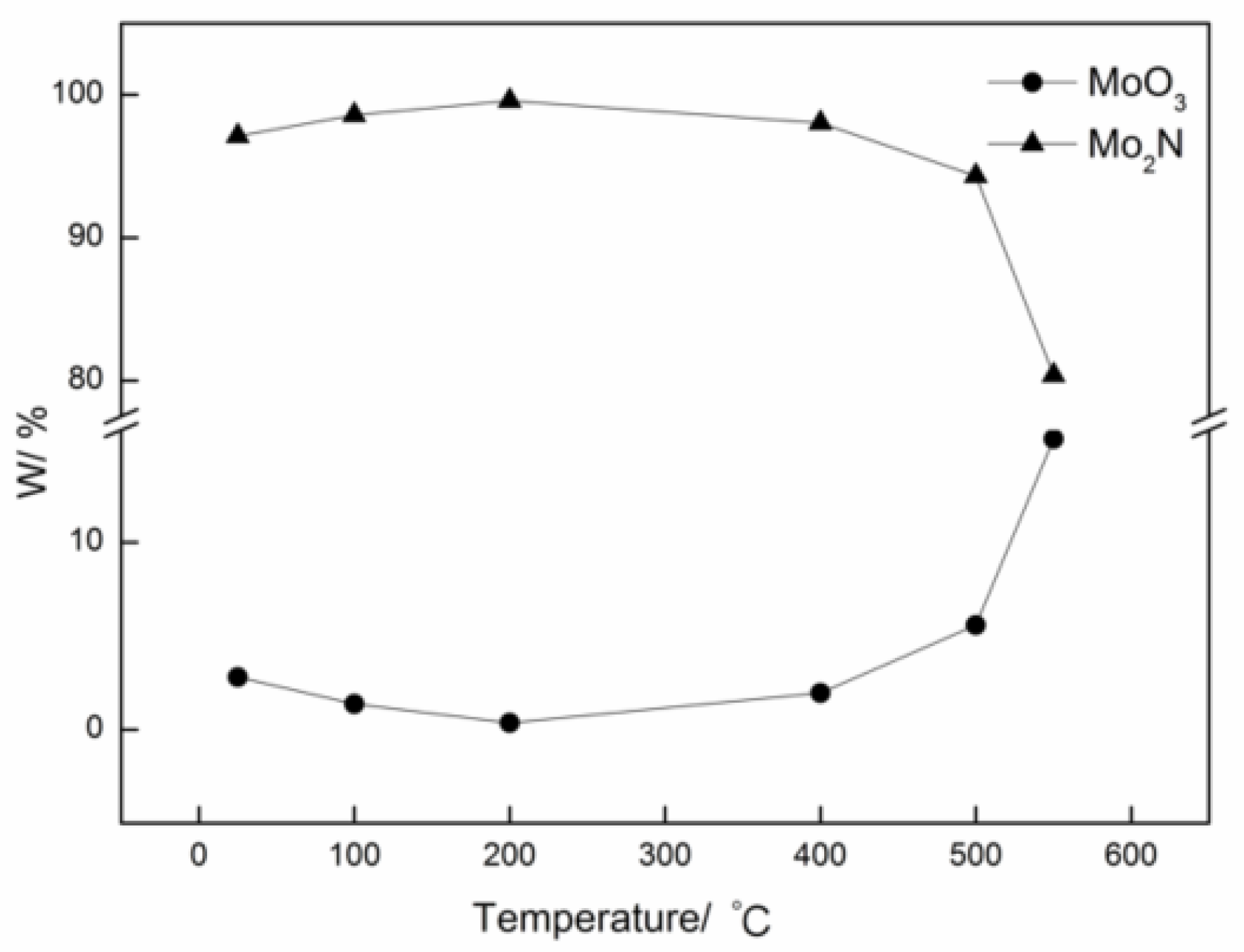
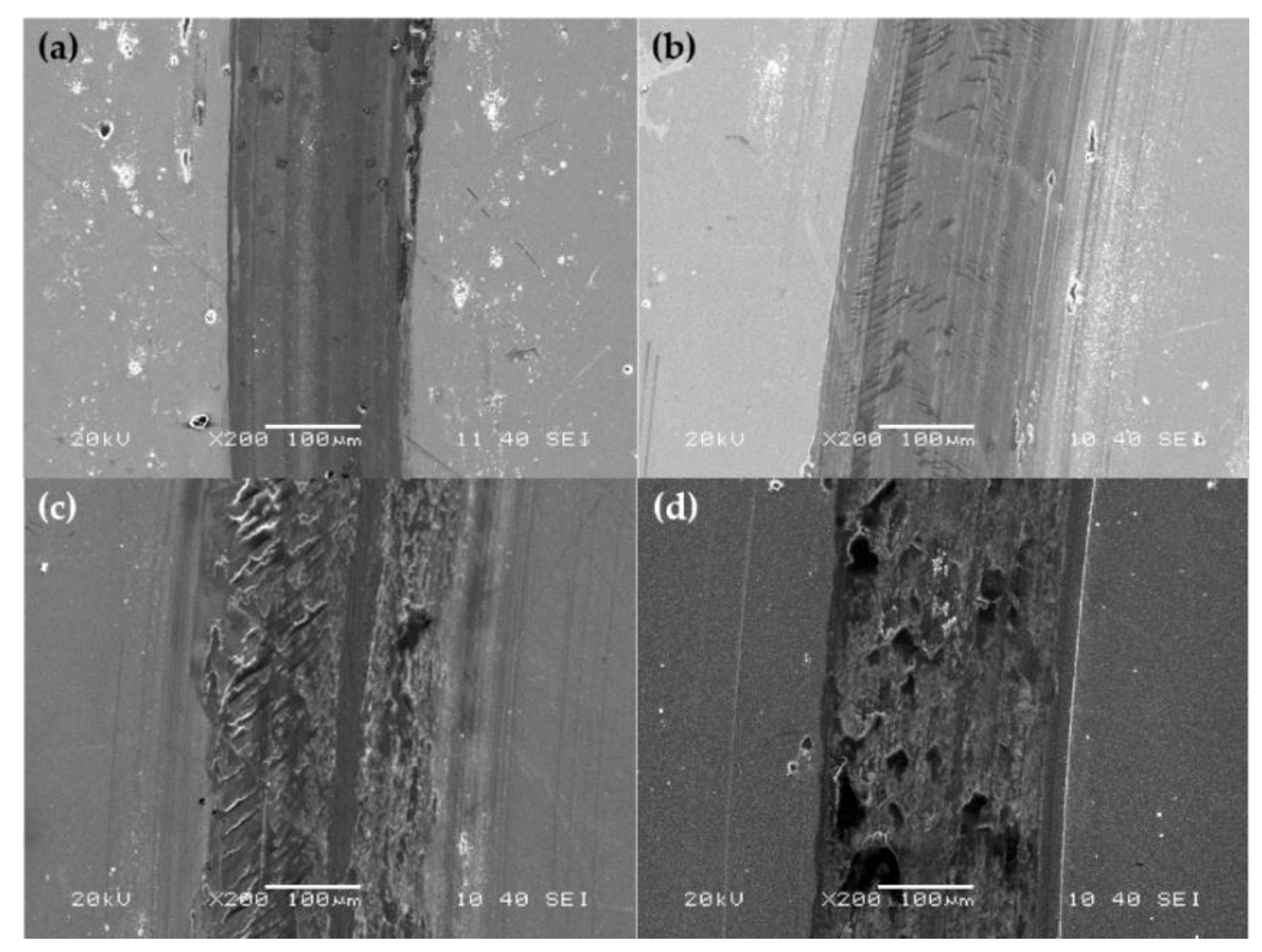
| Testing Temperature (°C) | Elemental Compositions (at.%) | |||
|---|---|---|---|---|
| Mo | N | O | Al | |
| 25 | 54.6 ± 2.7 | 38.7 ± 1.9 | 6.7 ± 0.3 | 0 |
| 200 | 56.7 ± 2.8 | 40.1 ± 2.0 | 3.2 ± 0.2 | 0 |
| 400 | 53.8 ± 2.7 | 35.4 ± 1.9 | 10.8 ± 0.4 | 0 |
| 550 | 42.2 ± 2.1 | 18.3 ± 0.9 | 39.5 ± 2.0 | 0 |
© 2019 by the authors. Licensee MDPI, Basel, Switzerland. This article is an open access article distributed under the terms and conditions of the Creative Commons Attribution (CC BY) license (http://creativecommons.org/licenses/by/4.0/).
Share and Cite
Liu, C.; Ju, H.; Yu, L.; Xu, J.; Geng, Y.; He, W.; Jiao, J. Tribological Properties of Mo2N Films at Elevated Temperature. Coatings 2019, 9, 734. https://doi.org/10.3390/coatings9110734
Liu C, Ju H, Yu L, Xu J, Geng Y, He W, Jiao J. Tribological Properties of Mo2N Films at Elevated Temperature. Coatings. 2019; 9(11):734. https://doi.org/10.3390/coatings9110734
Chicago/Turabian StyleLiu, Chenkai, Hongbo Ju, Lihua Yu, Junhua Xu, Yaoxiang Geng, Wenxiang He, and Jixuan Jiao. 2019. "Tribological Properties of Mo2N Films at Elevated Temperature" Coatings 9, no. 11: 734. https://doi.org/10.3390/coatings9110734
APA StyleLiu, C., Ju, H., Yu, L., Xu, J., Geng, Y., He, W., & Jiao, J. (2019). Tribological Properties of Mo2N Films at Elevated Temperature. Coatings, 9(11), 734. https://doi.org/10.3390/coatings9110734





